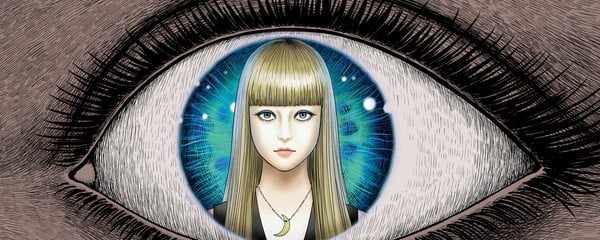Mini-Interview with Master of Horror Junji Ito
by Lynzee Loveridge,
Junji Ito was a guest at this year's Virtual Crunchyroll Expo to talk about his manga Junji Ito's Cat Diary: Yon & Mu, one of the acclaimed horror artist's many licensed manga. Ito is horror manga mainstay in both Japan and North America. His story collections are released stateside on a yearly basis and often climb their way onto the Amazon bestseller lists. Now, with an Eisner award under his belt, Anime News Network caught up with Ito to discuss pets, fashion, and the spine-tingling inspiration behind some of his most haunting tales.
In Yon & Mu, you were able to capture the "horrors" of pet ownership in a fresh and funny way. I was wondering since Yon's passing, have you welcomed any more pets into your life and what interesting quirks they may have?
Junji Ito: Since Yon and Mu passed on, we've now got two new cats. When they get hungry, they come to the door to my room and start playing with the knob, trying to open it, which makes a lot of noise. I've also had pet beetles before, and right now we've got a stag beetle that my daughter found in the house. My wife also has four lizards on the bigger side that she's keeping at the moment.
In the last few years, many of your characters have appeared on apparel here in the United States. Do you have any input in the Junji Ito fashion line? How would you describe your clothing style?
Junji Ito: I've got real a lack of fashion sense, and can only barely put myself together enough to look presentable. Since I don't have a lot of confidence in my body, I try to go for clothes that don't attract a lot of attention. And with that being the case, I don't really have any demands for the apparel lines that use my characters.
Symbols can be a great source of horror on the primordial level. What do you think it is about a spiral (Uzumaki) that is unsettling to people?
Junji Ito: A spiral on the surface of water has the ability to draw things below that surface, and I think there's an inherent fear with that notion. There's also the fact that the center of a spiral only ever leads deeper and deeper inwards, and there's something frightening about considering the implications of the infinite.
Your short story "The Enigma The Amigara Fault" might be one the most well-known among English readers. How did you conceptualize this story and how would you describe what makes it scary?
Junji Ito: "The Enigma of Amigara Fault" began with the image of "a hole in the shape of a person." From there it becomes a question of "What if that hole was a perfect fit for you? Who would've made it? And where it might lead?" I think if someone were actually inside of a hole like that, they'd end up with an intense sensation of being trapped. A part of this is tied to my own fears, like the dissonance you feel when you hear your voice recorded or see yourself on video, that kind of unpleasantness that comes of looking at yourself from the outside. Doppelgangers are something I'm really fond of conceptually, and I think the concept is applicable to Amigara.
Many horror stories focus on certain anxieties, compulsions, or feelings that grow out of control. Do you feel like there's a central emotional theme to your stories?
Junji Ito: One of the themes of Tomie is narcissism taken to an extreme. There are other works of mine that deal with that kind of self-love too. I think that sort of self-fixation is something that everyone has to some extent, and by exaggerating it, you get something readers can easily understand. Related to that are things like dependence, and anxiety, of which anxiety can be at the core of a lot of other emotions. The root of fear is anxiety, I think, and I would say that the majority of human actions (and even animal actions) are motivated by a desire to assuage anxiety.
Junji Ito's upcoming release Remina, is a sci-fi tale that will hit bookstores in December. The artbook The Art of Junji Ito: Twisted Visions was released in April followed by Venus In The Blind Spot in August.